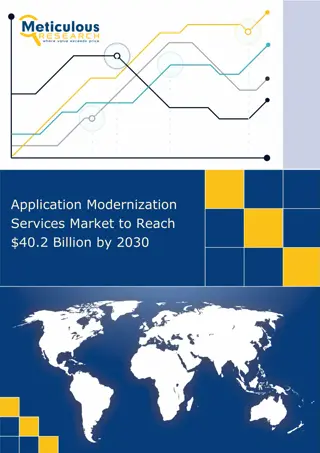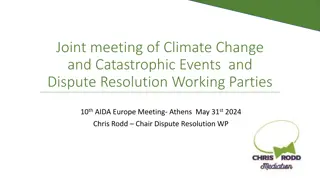World Bank Guarantee Policy Modernization Consultation
The World Bank is conducting global consultations to modernize its guarantee operational policies, seeking inputs from various stakeholders like governments, private sector investors, and development organizations. The consultations aim to improve the effectiveness of World Bank Guarantees in mobilizing private financing for sustainable development and poverty reduction. The presentations cover the value added by World Bank Guarantees, the need for modernization, and proposals for consultation.
Download Presentation

Please find below an Image/Link to download the presentation.
The content on the website is provided AS IS for your information and personal use only. It may not be sold, licensed, or shared on other websites without obtaining consent from the author. Download presentation by click this link. If you encounter any issues during the download, it is possible that the publisher has removed the file from their server.
E N D
Presentation Transcript
Modernizing World Bank Guarantee Products Guarantee Policy Modernization Spring Meetings Consultation 2012 Operational Policies and Quality (OPCCS) 1
Consultations The Bank is conducting global consultations on the proposed modernization of its guarantee operational policies, in order to elicit inputs and feedback from a wide range of stakeholders in as broad and inclusive manner as possible. Approach Paper and a range of consultation materials are publicly available on www.worldbank.org/guaranteesconsultation Consultations will include representatives of governments, private sector investors and financiers, CSOs, and multilateral and bilateral development organizations The consultations will be carried out from January to April 2012, utilizing the following channels: Website Face-to-face forums Videoconferences Based on the consultations, Management plans to develop the Approach Paper into a policy paper and present it to its Board for approval 2
Structure of the Presentation 1. Value Added of World Bank Guarantees 2. Guarantee Products and Operations to Date 3. The Need for Modernization 4. Modernization Proposals and Issues for Consultation 3
What are World Bank Guarantees? Bank guarantees are one of Bank s four development finance instruments Complementary to investment lending (IL), Program-for- Results (P4R) financing and development policy lending (DPL) In providing guarantees, Bank s objective is to mobilize private financing for development purposes, in support of sustainable development and poverty reduction Developing countries have significant financing gaps, estimated at 7 to 9 percent of GDP per year, for infrastructure and other public investments Guarantees support government strategies and associated policy dialogue Guarantees leverage the Bank s own limited resources 5
Private sector is important source of funding but is cyclical
. . . and uneven across countries Source: World Bank and PPIAF, PPI Project Database. (http://ppi.worldbank.org) PPPs mobilized $170 Bn of investment (in 2010) compared to about $95 Bn in resources from MDBs and ODA (in 2009) 7
Why are guarantee instruments so relevant in the current environment? Support infrastructure investment plans: Improves access to affordable financing for infrastructure investments (longer maturities, lowering spreads) Facilitate access to increasingly tight markets: Euro crisis has weakened the banking industry and reduced the risk appetite of private financiers Respond to the current banking industry environment and regulations: BASEL III regulations will increase funding costs, particularly for long-term non-recourse debt Develop local markets: Opens access to long-term local liquidity that is locked due to an inexistent transaction track record or shallow markets 8
World Bank Guarantee Products and Operations to Date 9
Partial Risk Guarantees Typical PRG Structure PRGs can cover a variety of risks associated with government contractual obligations, including the risk of non-payment by a government/SOE, regulatory risk, and expropriation risk. 11
Partial Risk Guarantees Kribi Power in Cameroon (2011) Opened new access to local long-term commercial financing, for US$82 million, thus developing the domestic financial sector. Supports the country s poverty reduction strategy which targets a substantial increase in supply of electricity. PRG complemented by: IFC A loan (US$86 million) Bank investment lending in support of rural electrification and strengthened management of environmental and social impacts 12
Partial Risk Guarantees Electricity and Gas in Nigeria (2009) Covers public power utility s payment obligations under gas supply agreements, for US$400 million through a Letter of Credit (L/C) structure Supports government s power sector reform strategy Additional financing for US$200 million currently being developed Power Generation in Kenya (2012) PRG series to cover public utility s payment obligations to four IPPs using a L/C structure, for US$166 million Supports the country s Vision 2030, by addressing acute power shortages through private financing, given fiscal constraints IFC is expected to provide loans and MIGA to offer PRIs for termination payment obligations under the Power Purchase Agreement 13
Partial Credit & Policy-Based Guarantees Typical PCG Structure PCGs can be offered to Governments, their political subdivisions and state-owned enterprises PBGs support sovereign borrowing associated with policy and institutional reforms 14
Partial Credit & Policy-Based Guarantees Morupule B PCG in Botswana (2010) Helped the country address a potential energy crisis Extended maturities of US$825 million loan from 15 to 20 years by covering debt service payments of US$243 million for those years Resulting lower revenue requirements benefited electricity consumers and economy in general through lower tariffs Serbia Private and Financial Sector PBG (2010) Improved access to markets constrained by global financial crisis, by covering bullet maturity of 400 million loan Supported reforms to improve business climate and strengthen financial system through restructuring of banking sector 15
Operational Track Record 41 guarantees in 31 countriesfor a total of $4.7 billion Significant leverage: $27.5 billion in project financingmobilized by guarantees for $3.2 billion Mostly PRGs, many in power sector: 29 PRG, 8 PCG and 4 PBG Mixture of IBRD and IDA: 24 IBRD guarantees and 17 IDA PRGs Allocation by Sector (in US$ million) Allocation by Region (in US$ million) MULTI-INFRA, $270 OTHER, $200 AFR, ECA, FISCAL SUPPORT, $944 $1,119.90 $1,209.60 OIL & GAS, $660 EAP, $688.00 POWER, $2,051 TRANSPORT, $55 SAR, $367.90 MNA, $375.00 FINANCE, $120 TELECOM, $250 LAC, $789.00 17 Note: Charts reflect operations approved through December 2011
Guarantee Modernization in Context Modernization of the operational policy is part of a broader Bank agenda for promoting private sector and infrastructure development: Modernization of Guarantee Policy Providing enhanced support for the preparation of PPP projects Improving the deployment of specialized staff skills Strengthening the outreach to clients and marketing of guarantees Enhancing WBG collaboration and coordination, among Bank guarantees, MIGA political risk insurance and IFC guarantees and lending 19
Why do Guarantee products need modernization? Bank guarantees could further respond to client needs for development financing Increased opportunities and unmet demand: Expansion of emerging markets since the Bank s guarantee instruments were introduced in 1990s Unmet demand for development financing lower down the income spectrum Constrained supply of development financing: Impact of the global financial and European sovereign debt crises Commercial lenders under pressure to increase capital and strengthen balance sheet Need to leverage limited Bank capital and constrained ODA 20
Purpose of Policy Modernization Support increased access to private development financing for member countries by: Streamlining, consolidating and enhancing the applicability of the guarantee instrument Removing any unnecessary and outdated policy provisions Ensuring borrowing is done in a prudent and sustainable manner Reflect G20 discussions on the need for greater use of WBG guarantees. 21
Key Modernization Proposals Two overarching themes to the proposed changes: 1. Extending PCGs and PBGs to IDA countries 2. Aligning policy requirements for guarantees with their corresponding lending instruments, thereby streamlining and consolidating requirements and making the instrument more timely and useable The proposed policy changes also seek to retain flexibility in structuring guarantee operations to fit specific client needs and project circumstances 23
Extending Partial Credit Guarantees to IDA countries PCGs would be available for IDA countries which have low risks of debt distress and adequate debt management capacity, but For countries which do not meet the country level criteria, there would be exemptions for projects with significant financial returns The proposed approach would help IDA countries address significant financing gaps and also ensure prudent and sustainable borrowing Both country and project considerations are reflected in the eligibility criteria 24
Extending Policy Based Guarantees to IDA countries PBGs would be available for IDA countries which have low risks of debt distress and adequate debt management capacity No exemptions are considered, as PBGs support borrowing for general budget financing and hence are not associated with a specific investment project The proposed approach would help IDA countries address significant financing gaps and also ensure prudent and sustainable borrowing 25
Aligning policy requirements for guarantees with lending instruments PRGs and PCGs & Investment Loans (ILs) Bank Safeguards: Supervise only up to the completion of the project that is benefiting from the guarantee (as in Investment lending) However, supervision would continue after project completion for any applicable legal covenants, if required by a specific safeguard policy, or to address Management concerns about compliance Sector policy framework. Standardize requirements across guarantee options regarding the requirement on sector policy framework Additional financing and project restructuring. Introduce additional financing operations and project restructuring to guarantees (currently available only for ILs) 26
Aligning policy requirements for guarantees with lending instruments PBGs & Development Policy Loans (DPLs) Allow the use of PBGs to support local in addition to international financing The country s reform program supported by the PBG would be assessed against the country s track record, as required for DPLs For countries that already have some market access, PBGs can be used to improve financial terms and achieve financial leverage PBGs will continue to be subject to the operational policies for DPLs 27
Further Innovations Innovation has been a key feature of Bank guarantee operations The operational policy on guarantees provides flexibility in structuring guarantee operations to fit specific client needs and project circumstances Specific structures have been developed to backstop government payment obligations Guarantee series and guarantee facilities provide a mechanism and framework for multiple guarantees As part of the policy paper, Management intends to explore the possibility of extending guarantees to: Carbon contracts to support low-carbon projects for reducing greenhouse gas emissions Hedging products 28
Consultations: Guiding Questions How can the guarantee instrument be designed to best help developing countries meet their development financing needs? Do you think that the proposed policy changes will enable better, more effective and broader use of the Bank guarantee instrument? If not, how can we improve it? Do you agree with the proposal to introduce partial credit guarantees (PCGs and PBGs) to IDA countries, based on new eligibility criteria? Do you think these criteria can help ensure that the resulting debt is prudently managed and sustainable? Do you think that the policy requirements for project-based guarantees should be aligned with those for investment lending, including the supervision responsibilities for Bank safeguard policies? Do you think that the policy requirements of policy-based guarantees should be aligned with those for DPLs? Do you think that the Bank should explore the possibility of extending guarantees to support low-carbon projects to combat climate change and also to hedging products? Do you have other suggestions or comments? 29























